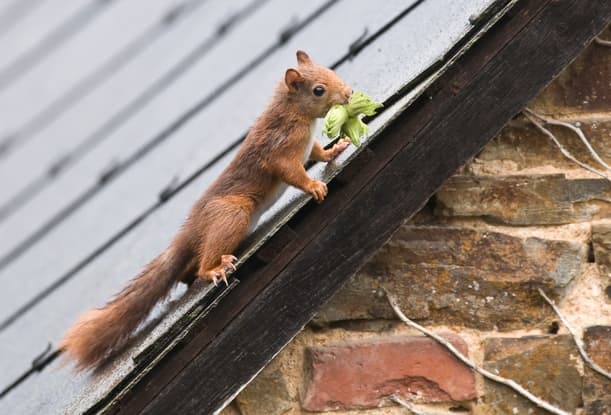Squirrels are among the more docile wildlife and rarely attack unless cornered. Even then, squirrels will rarely use direct confrontation as a defensive means and are more likely to run away, sometimes even swim, to evade predators. These critters have a repertoire of defensive measures that they take to protect themselves from predators.
Be careful of aggressive squirrels as this is one of the most common signs of rabid squirrels. Although a very rare occurrence, you are at risk of contracting rabies by getting scratched or bitten by a rabid squirrel.
Squirrel Predators
Squirrels have plenty of natural predators to be concerned about. Common ones include large snakes, red foxes, coyotes, weasels and raccoons. Large predatory birds such as owls, eagles, falcons and hawks will also take any opportunity to snatch and eat a squirrel.
In urban areas squirrels are at risk from cats and dogs and humans who may run them over or actively hunt, trap or poison squirrels.
Squirrel Defense Mechanism
Squirrels will rely on a variety of methods to defend themselves from predators, often employing two or more of these tactics at the same time. Nursing squirrels are also very protective of their kittens and may be uncharacteristically aggressive while trying to defend their litter.
Alarm Calls
Squirrels have a complex repertoire of alarm calls that they use for predators. These range from a broad-frequency, short and sharp sound known as a ‘Kuk’ to a whistle-like tonal moan. The squirrel combines these noises with specific tail signals such as a wave-like twitch that runs through the tailor a more noticeable whipping motion. Researchers from the University of Miami suggest that these combinations of sounds and tail motions may be predator-specific, such that the animal will use a unique combination of sound and tail motion for terrestrial predators like domestic cats and a different one for areal predators like owls.
The alarm calls aren’t to scare off the predator but rather to let the predator know that it has been spotted and to warn other nearby squirrels of impending danger. Some predators such as domestic cats prefer not to attack if they lose the element of surprise.
Camouflage
Squirrels blend in well with their surroundings and like to keep their foraging around trees. A squirrel will move from one side of the tree trunk to the other and keep perfectly still to confuse the predator. Some such as the flying squirrel will go out specifically on nights with low-visibility to keep themselves hidden as they forage.
Speed
Squirrels are among the quickest ground animals and rely on their speed, agility and dexterity to run away from prey. A squirrel can scurry up a tree in less time than it takes most predators to get their paws on the rodent. The squirrel is also apt at moving from tree to tree with ease which makes it difficult for predators to keep up.
Tail
Along with warning other squirrels, the animal will wave its tail to distract predators. A squirrel’s tail will actually break off if caught by an animal allowing it to escape. This defence mechanism is common with lizards but unlike lizards, the squirrel can’t grow back its tail. The animal can, however, cope quite well with life without a tail.
Infrared
Squirrels seem only to deploy this defence mechanism with rattlesnakes. Pit vipers, including rattlesnakes, have pit organs which are holes on their faces that they use to detect their prey using infrared radiation that the animal emits. It is much like having infrared vision.
Squirrels heat up its tail and flail the hot tail. The science is not exact on whether the flailing tail mimics a more aggressive animal or whether it confuses the rattlesnake in some other way but this seems to make the snake recoil in a defensive position and not attack. This strategy works best at night where the cooler temperature contrasts starkly with the squirrel’s tail temperature. Experts agree that squirrels don’t do this with any other snake except the rattlesnake.
Attack
Finally, although rare, squirrels will full-on attack if threatened. Nursing mothers are more likely to attack especially if the nest is under threat. The squirrels typically fight to the death with snakes and other reptiles and will stand on its feet and make aggressive noises and gestures to look larger. Rabid squirrels are quick to attack with little motivation.
Hire an Expert to Remove Squirrels from Your Property
Squirrel bite or scratch, even by accident, can spread diseases to humans some of which are fatal. Squirrels are also most likely to injure your pets and young children who are more curious and less likely to discern the behaviour of a wild animal that is gearing up to attack.
Wildlife feces and urine also carry parasites, bacteria and viruses that are spread to human beings through contaminated water and food. Fleas and ticks from wildlife also spread diseases including Lyme disease and plague. This is why you should let an expert squirrel removal company in Toronto handle squirrels in the attic or wherever else they are nesting. The professional will remove the animals safely, clean up the toxins left behind including pheromones that attract other wildlife and seal up your home to avoid the wildlife breaking in again. Hire a company that provides a warranty for the removal.
